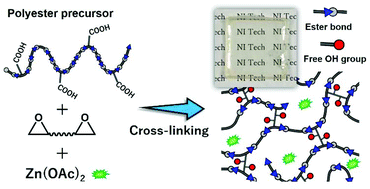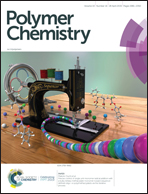Synthesis of amorphous low Tg polyesters with multiple COOH side groups and their utilization for elastomeric vitrimers based on post-polymerization cross-linking†
Abstract
In this research, we demonstrate the preparation and unique functions of elastomeric polyester vitrimer materials with different cross-link densities based on a post-polymerization cross-linking method. First, we synthesize polyesters with thiol (SH) groups at the side groups via melt polycondensation of pentanediol, adipic acid, and thiomalic acid. The SH-attached polyester is reacted with acrylic acid through the Michael addition reaction between the SH side groups of the polyester and the vinyl groups of acrylic acid, providing viscous amorphous polyesters with multiple COOH side groups (PE-COOH). PE-COOH polymers are cross-linked through the reaction with a diepoxy cross-linker (1,4-butanediol diglycidyl ether) in the presence of a trans-esterification catalyst Zn(OAc)2 at 120 °C. This cross-linking via the COOH–epoxy reaction generates free OH groups in the network, which act as the carriers for trans-esterification with ester bonds in the polyester strands. In this design, the COOH group equivalent weight (MCOOH) in PE-COOH is easily tuned by the initial polycondensation feed ratio between adipic acid and thiomalic acid. This also enables the tuning of the cross-link density and the fraction of free OH groups in the final vitrimer materials as reflected in the tensile and swelling properties. The representative vitrimeric properties, including the softening temperature (Tsoft) and stress-relaxation at high temperature, are all affected by the cross-link density (i.e., MCOOH in PE-COOH). Interestingly, a lower Tsoft and a shorter relaxation time were attained for the sample with a larger cross-link density. This is because the sample with the larger cross-link density possesses a larger fraction of the bond-exchange carriers, i.e., free OH groups, in the present system, which enables the activation of trans-esterification based bond-exchange with lower temperature and higher frequency.

- This article is part of the themed collection: Polymer Chemistry 15th anniversary regional spotlight collection: Asia-Pacific


 Please wait while we load your content...
Please wait while we load your content...